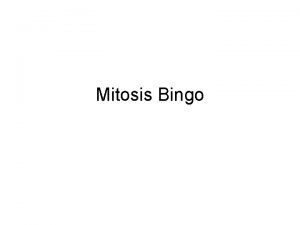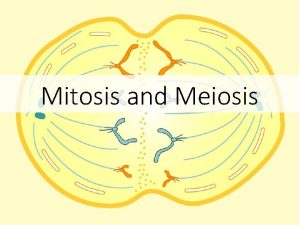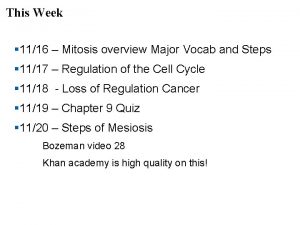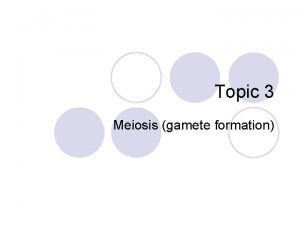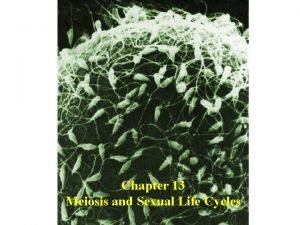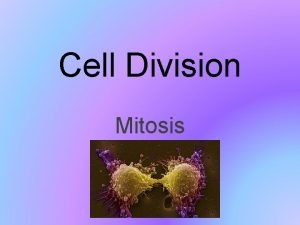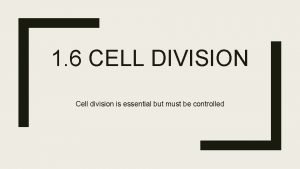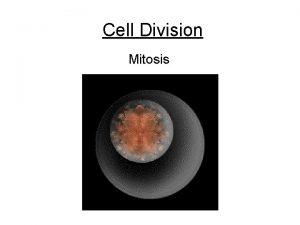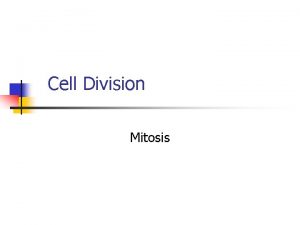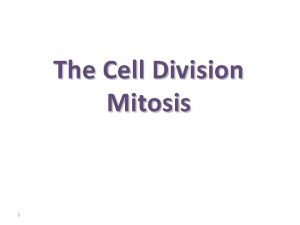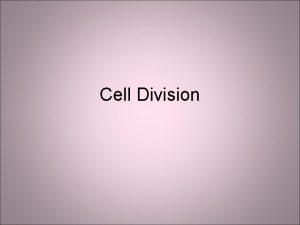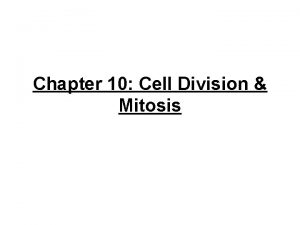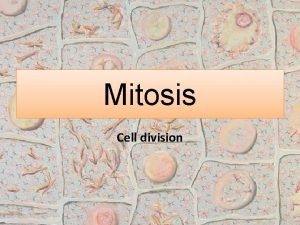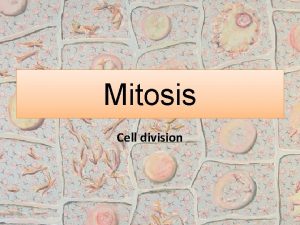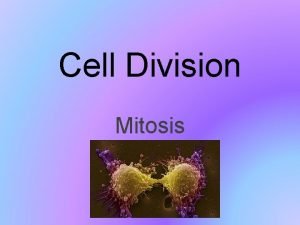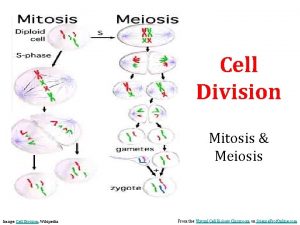Mitosis A Type of Cell Division Mitosis One




















- Slides: 20

Mitosis A Type of Cell Division

Mitosis • One human cell eventually multiplies to several hundred trillion producing a human being. This process is called MITOSIS. • It is the event that ensures that every cell in your body has the identical set of genetic instructions or DNA.

• Cells become ready for mitosis by making copies of their DNA, this process is called replication. • Each double stranded chromosome contains two chromatids, joined by a centromere.


The Phases of Mitosis • The phases of mitosis include, prophase, metaphase, anaphase and telophase. • Cells spend most of their time in interphase.


Importance of Mitosis: • • • Growth Repair Replacing dead and damaged cells Asexual reproduction To ensure that each daughter cell maintains exactly the same number and kind of chromosomes as the parent cell. • Produces two identical daughter cells

Interphase (Resting stage) • Chromosomes cannot be seen • Chromosomes duplicate and double in number

Interphase Animal cell Plant cell

Prophase nuclear membrane chromatids centromere disappearing • Chromosomes become visible • Each chromosome consists of two identical chromatids homologous chromosomes

Prophase Animal cell Plant cell

Metaphase • Chromosomes line up at the equator (centre of the cell) • Spindles are formed to attach to the centromere of each chromosome

Metaphase Animal cell Plant cell

Anaphase • Sister chromatids separate as individual chromosomes • They move apart towards the opposite poles chromosomes

Anaphase Animal cell Plant cell

Telophase nuclear membrane forming • Chromosomes gradually disappear • Nuclear membrane is forming around each set of chromosomes

Telophase Animal cell Plant cell

Cytoplasmic division • Division of cytoplasm Animal cells : by formation of cleavage furrow Plant cells : by formation of cell plate cleavage cellfurrow plate

Can you identify the different stages of mitosis from the diagram below? anaphase interphase telophase metaphase prophase

Animation • http: //www. cellsalive. com/mitosis. htm
 Mitosis meiosis
Mitosis meiosis Cell division mitosis and meiosis
Cell division mitosis and meiosis Mitosis
Mitosis Cell cycle and cell division
Cell cycle and cell division Cell cycle and cell division
Cell cycle and cell division Cell cycle phases
Cell cycle phases Type of cell division
Type of cell division Rock cycle sedimentary
Rock cycle sedimentary Handwriting คือ
Handwriting คือ Sequence the mitotic phase
Sequence the mitotic phase Mitosis division
Mitosis division Crossing over during prophase 1
Crossing over during prophase 1 Mitosis division
Mitosis division Recombinant chromosomes
Recombinant chromosomes Ipmat mitosis
Ipmat mitosis Cleavage furrow in cell division
Cleavage furrow in cell division Mitosis division
Mitosis division Short division vs long division
Short division vs long division Long division and synthetic division
Long division and synthetic division Long division how to
Long division how to What is synthetic division
What is synthetic division


